Elastix PBX Installation & Setup Guide | DasTech Solutions
1. Introduction to Elastix PBX
1.1 What is Elastix PBX?
Elastix PBX is an open-source Unified Communications Solution that integrates VoIP (Voice over IP) capabilities, instant messaging, email, and collaboration tools into a single platform. It is built on Asterisk, the world’s leading open-source PBX software, and includes FreePBX for a user-friendly web interface.
1.2 Why Choose Elastix for Business Communications?
Elastix is a cost-effective solution for businesses looking to implement a professional VoIP phone system. Unlike traditional PBX systems, Elastix does not require expensive hardware or long-term contracts. Businesses can manage and scale their phone systems without significant costs.
1.3 Benefits of Elastix PBX Over Other VoIP Solutions
- Open-Source & Free: Unlike proprietary PBX systems, Elastix is free to use, reducing operational costs.
- Highly Scalable: Whether you’re a small business or a large enterprise, Elastix supports unlimited extensions and users.
- Feature-Rich: Includes IVR, voicemail, call recording, conferencing, SIP trunking, and more.
- Remote Work Support: Employees can make and receive calls from softphones, mobile apps, or IP phones from anywhere.
- Secure & Reliable: With built-in security features like SIP encryption, fail2ban, and firewall configurations.
1.4 How DasTech Solutions Can Help with Your Elastix Setup
At DasTech Solutions, we specialize in setting up, configuring, and maintaining Elastix PBX for businesses of all sizes. Our team ensures your PBX is optimized for performance, security, and efficiency, allowing your business to run smoothly.
2. System Requirements for Elastix Installation
Before installing Elastix PBX, it is essential to meet the hardware and network requirements to ensure smooth operation.
2.1 Hardware Requirements

2.2 Supported Operating Systems
Elastix is based on CentOS Linux and requires a compatible OS environment:
- CentOS 7 (Recommended)
- Red Hat Enterprise Linux (RHEL) 7
- Ubuntu (For custom installations)
2.3 Recommended Network Infrastructure
- Stable Internet Connection with at least 10 Mbps upload/download speed.
- Static IP Address for better VoIP connectivity.
- Asterisk-Compatible SIP Trunks for external calls.
- QoS (Quality of Service) enabled on routers to prioritize voice traffic.
3. Downloading and Preparing Elastix
3.1 Where to Download Elastix PBX
Elastix can be downloaded from the official website or a trusted repository. Ensure you download the latest stable version.
3.2 Choosing the Right Version
- Elastix 4.0: Recommended for stable enterprise use.
- Elastix 5.0: Includes additional UC features but requires a paid subscription.
3.3 Creating a Bootable USB/DVD
Use Rufus (Windows) or Etcher (Mac/Linux) to create a bootable USB from the ISO file.
3.4 Configuring BIOS for Installation
- Restart your system and enter BIOS (Press F2, F12, or DEL).
- Set USB Drive as the primary boot device.
- Save changes and reboot.
4. Step-by-Step Installation of Elastix PBX
4.1 Booting from Installation Media
- Insert the USB/DVD and boot into the Elastix installer.
- Select Install Elastix and press Enter.
4.2 Selecting Language and Keyboard Preferences
- Choose your preferred language (e.g., English) and keyboard layout.
4.3 Partitioning and Disk Setup
- Select Automatic Partitioning (recommended for beginners).
- Advanced users can create custom partitions for better performance.
4.4 Configuring Network Settings
- Assign a Static IP Address for server accessibility.
4.5 Setting Up Time Zone and Date/Time
- Select your region and enable NTP (Network Time Protocol) for accurate timing.
4.6 Creating an Administrator Account
- Set up the root password and admin credentials for security.
5. Initial Configuration After Installation
5.1 Logging into the Elastix Web Interface
- Access the web UI via
https://your-server-ip/in a browser.
5.2 Understanding the Elastix Dashboard
- Dashboard provides call statistics, user extensions, SIP trunk statuses, etc.
5.3 Configuring Network and Security Settings
- Enable fail2ban, IPtables, and SSH security for protection.
6. Setting Up VoIP Trunks and Routes
6.1 Understanding SIP and IAX Trunks
- SIP (Session Initiation Protocol) is the most common VoIP protocol.
- IAX (Inter-Asterisk Exchange) is used for Asterisk-based PBX systems.
6.2 Configuring Inbound and Outbound Routes
- Set rules to route calls efficiently.
7. Call Features and Customization
7.1 Setting Up IVR (Interactive Voice Response)
- Create an auto-attendant menu for directing calls.
7.2 Configuring Voicemail and Call Forwarding
- Customize voicemail settings for each extension.
8. Securing Your Elastix PBX
8.1 Best Practices for PBX Security
- Use strong passwords and change them regularly.
8.2 Configuring Firewall and Fail2Ban
- Block unauthorized access attempts automatically.
9. Integrating Elastix with Other Systems
9.1 Connecting Elastix with CRM and ERP Systems
- Use APIs to sync with CRM tools like Salesforce.
9.2 Using Elastix with Softphones and Mobile Apps
- Configure mobile VoIP apps like Zoiper and Linphone.
10. Troubleshooting and Maintenance
10.1 Common Issues and Fixes
- No audio in calls? Check NAT and firewall settings.
- Dropped calls? Verify SIP provider settings.
10.2 Updating and Upgrading Elastix PBX
- Keep your system updated for security patches.
11. Why Choose DasTech Solutions for Elastix PBX Deployment?
At DasTech Solutions, we provide:
✅ Professional Elastix Installation & Configuration
✅ 24/7 Technical Support & Maintenance
✅ Custom VoIP Solutions for Businesses
✅ Security & Performance Optimization
📞 Contact Us Today for Expert Elastix PBX Installation!
